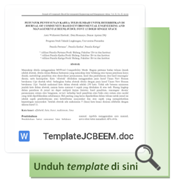Study of Potential Utilization of Recycling Ablution Used Water, Case Study at Ulul Albaab Mosque, Universitas Pasundan, Bandung, Indonesia
DOI:
https://doi.org/10.23969/jcbeem.v6i2.6150Keywords:
ablution water, mosque activities, non-consumption needs, recyclingAbstract
The role of water in daily life, including activities in the mosque is very significant. The existence of the Ulul Albaab Mosque which is always busy with various congregation activities and activities carried out by students and the campus community affects the need for clean water. So far, the ablution used water at the Ulul Albaab Mosque has been dumped into the sewers. Measuring the quantity of water to determine the volume of ablution used water at the time of obligatory prayer is the first step to assessing its potential utilization. The number of congregation who perform ablution is directly proportional to the number of congregation of the Ulul Albaab Mosque. The average congregation of the mosque is 857 people/day and the average number who perform ablution is 778 people/day. The results showed that the volume of water used for ablution was 3.9 liters/person with an average time required for ablution of around 64 seconds. The use of recycling ablution water can be used for non-consumption needs.
Downloads
References
Alfiah, T., Kusuma, M.N. & Damara, R.R. (2015). Potensi Pemanfaatan Air Bekas Setelah Diolah Menggunakan Saringan Pasir. Seminar Nasional Sains dan Teknologi Terapan III 2015 Institut Teknologi Adhi Tama Surabaya.
Bahagia, M. N. (2018). Analisis Pengelolaan Air Bekas Wudhu ’ Jamaah Mesjid Jamik Lambaro Kabupaten Aceh Besar. Serambi Engineering, III(1), 209–214.
Jacob, D.E. & Sandjaya, S. (2018). Faktor Faktor Yang Mempengaruhi Kualitas Hidup Masyarakat Karubaga District Sub District Tolikara Propinsi Papua. Jurnal Nasional Ilmu Kesehatan, 1(69), 1–16.
Lubis, M.N. & Sutisna, S.P. (2022). Desain Sistem Penggunaan Kembali Limbah Air Wudhu di Masjid An-Nashr Cilendek Timur Bogor Sesuai Syariat Islam. Jurma, Jurnal Program Mahasiswa Kreatif, 6(1), 131-140, Doi: 10.32832/jurma.v6i1. 1158
Madona, S., Rahmaniar, I., Nursetyowati, P., & Brunner, I. M. I. M. (2014). Laporan Akhir Penelitian Pengelolaan Air Bekas Wudhu Di Lingkungan Kampus Universitas Bakrie Jakarta. Universitas Bakrie Kampus Kuningan Kawasan Epicentrum.
Mafra, R. (2018). Pengukuran Durasi Waktu Berwudhu dan Volume Penggunaan Air Pada Masjid-Masjid di Kota Palembang Measurement of Duration of Ablution Time and Volume of Water Use In mosques in the city of Palembang. Jurnal Arsitektur, 2, 71–79.
Rachmadhi, A. H., & Moersidik, S. (2016). Potensi daur ulang greywater untuk kebutuhan air operasional ( kajian : pemanfaatan air bekas wudhu untuk kebutuhan air non- konsumsi di Masjid Istiqlal , DKI Jakarta ) = Greywater recycling potential for operationsl water necessity (study of utilization waste ablution water for non- consumption water necessity in Istiqlal Mosque , DKI Jakarta ), Tesis Universitas Indonesia.
Said, N. I. (2018). Daur Ulang Air Limbah (Water Recycle) Ditinjau Dari Aspek Teknologi, Lingkungan Dan Ekonomi. Jurnal Air Indonesia, 2(2). https://doi.org/10.29122/jai.v2i2.2300
Setiawan, N. (2005). Diklat Metodelogi Penelitian Sosial. Inspektorat Jenderal Departemen Pendidikan Nasional Daftar,25–28. http://pustaka.unpad.ac.id/wp-content/uploads/2009/03/teknik_sampling1.pdf
Suratkon, A., Chan, C. M., & Tuan Ab Rahman, T. S. (2014). SmartWUDHU’: Recycling Ablution Water for Sustainable Living in Malaysia. Journal of Sustainable Development,7(6),150–157. Doi: 10.5539/jsd.v7n6 p150
Sutrisno, J. (2016). Analisis Kualitas Air Bekas Wudhu di Pondok Pesantren Putra Darusy Syahadah Untuk Budidaya Ikan Nila. Seminar Nasional Pendidikan Biologi Dan Saintek II, 5–8.
Taylor, B. (2016). The Greening of Religion Hypothesis (Part One): From Lynn White, Jr and Claims That Religions Can Promote Environmentally Destructive Attitudes and Behaviors to Assertions They Are Becoming Environmentally Friendly. Journal for the Study of Religion, Nature and Culture, 10(3), 268–305. https://doi.org/10.1558/jsrnc.v10i3.29010
Yustiani, Y.M., Wahyuni, S., Kadir, A.A.A. (2019). Identifikasi Laju Deoksigenasi di Daerah Padat Penduduk (Studi Kasus Sungai Cicadas, Bandung). Journal of Community Based Environmental Engineering and Management, 3(1), 9-14.














